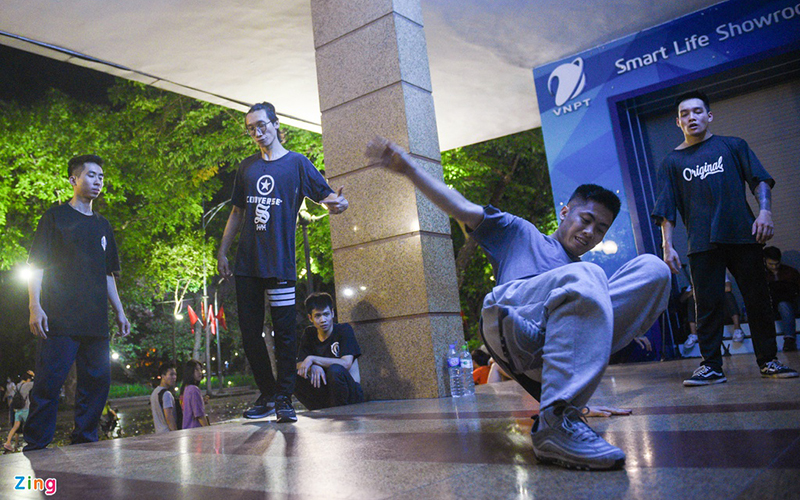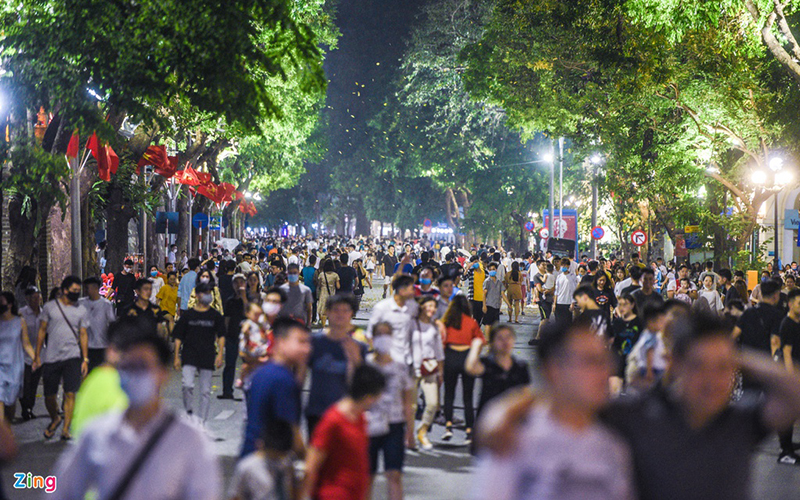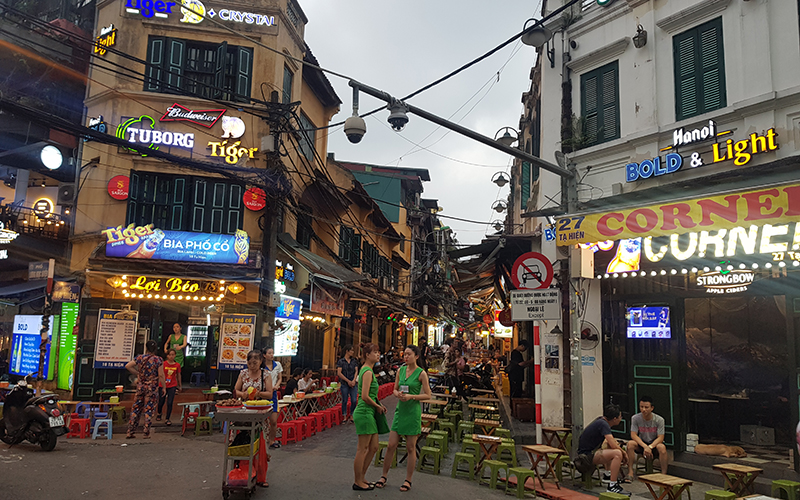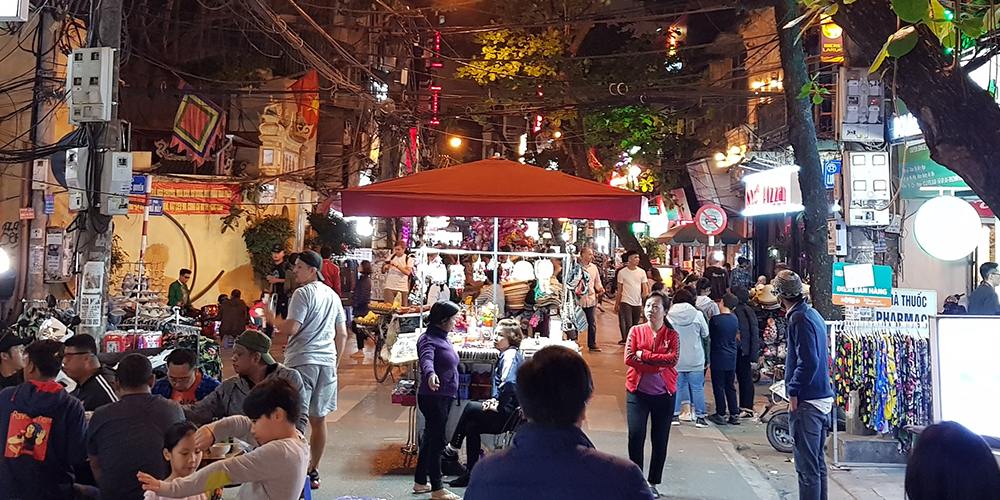The blue and yellow logo of the Vietnam Post building basks peacefully in the glow of the slowly lowering Sunday afternoon sun, on the eastern side of Hoan Kiem Lake, the heart of Hanoi.
On the forecourt, before it, however, energy levels are high. A crowd is forming a circle, excitedly chatting, and those at the back stand on their tiptoes, straining their necks, to see what all the fuss is about.
| Young people dance on the entrance of VNPT buiding after the pedestrian street around Hoan Kiem Lake was reopened on May 15. Photo: Zing |
Inside the circle, seven or eight high school students are dressed in designer black rags. The boys have bleached blond hair. The girls are made up with pale cheeks and bright red lips. They all wear dark eye makeup and are standing frozen in formation.
Music begins to emanate from a boombox hidden somewhere among the crowd. It rises up and begins to sift its way out over the mass of people, growing louder and faster as it does. Then the beat drops and the performers are shocked into life. They stomp their feet and pump their fists in the air, performing a well choreographed dance routine for the bemused and curious onlookers.
This is nothing out of the ordinary for Hoan Kiem Lake. This is a very normal, run of the mill, K-pop video, routine taping.
It is, however, on the sidelines of this street performance, that the effects of Covid-19 are most visible.
| The pedestrian street in downtown Hanoi is bustling again after its reopening on May 15. Photo: Zing |
Only a few months ago the number of foreign tourists circling street performers like these, on an idle Sunday, would have almost outnumbered the local Vietnamese. But not anymore.
Like most cities around the world, Hanoi is also entering a ‘new normal’ although markedly different from many other places.
In most countries there are limits to the number of patrons that can attend a bar or club. It is mandated that tables and chairs must be spaced a certain distance apart in restaurants, and the number of people at public gatherings is limited.
Other places around the world have a ‘new normal’ that means living heavily regulated lives under threat of even heavier penalties.
Hanoi, however, never felt the full impact of community transmissions of Covid-19 like other cities did. Official government figures have the infection rate at just 333 with no recorded deaths in the entirety of Vietnam. The country has gone nearly two months with no local transmission.
Hanoi’s ‘new normal’ therefore, is much freer than most and the changes have been limited.
That said, there are some noticeable differences between then and now.
| Ta Hien Corner. Photo: Mark Barnes |
For example, two Fridays after social distancing restrictions ended, Ta Hien Corner, more commonly known as Beer Street or sometimes Pho Tay (Foreigner Street), was almost as crowded as it had been before the pandemic took hold.
For years Beer Street had been Hanoi’s playground for backpackers, tourists, and expats from all around the world. Its tiny plastic stools had catered to many an overweight foreign backside or sent cramps shooting through the legs of too-tall foreign frames.
That said, where once it was a melting pot of people of all races and ethnicities, the crowd on this particular Friday night was now distinctly young and Vietnamese. The experience had become more local and in many ways it felt a lot more authentic.
That said, beyond Beer Street the impacts of Covid-19, particularly on the atmosphere of the Old Quarter, can be much more acutely felt.
“It’s definitely a lot quieter,” says Jake, a British expat and English teacher, who, along with his partner Katie, founded the travel blog Untold Wanderlust.
Jake and Katie have been living in Hanoi for the past two years travelling around Vietnam and blogging about their experience.
Jake says in the past they would often go into the Old Quarter to make friends with travellers passing through and to hear about their adventures. This, however, is no longer possible.
“There’s no tourists,” Jake says. “There’s no white people about… There’s no one wearing those watermelon shirts… you know, the tourist uniform that everyone wears.”
A quick walk through the night market reveals shop after shop, that before would have been full of souvenirs and fruit shirts, but that now are shuttered and available for rent.
| Night market in the Old Quarter. Photo: Mark Barnes |
Attitudes at Hanoi’s night market have changed too. Where foreigners were often all considered to be tourists and, by extension, assumed to be prepared to spend big, vendors are well aware this is no longer the case.
“We went to the night market on Friday and it was just easier to buy things,” says Katie.
She says prices were more reasonable from the outset and there was no attempt to charge anything beyond what was reasonable.
“It’s because no tourists are coming in, so any foreigner they see they know that we live here, they know we’re not travelling,” Jake adds.
It’s not only at the night market, however, where discounts can be found.
Getting around the city has become easier and cheaper too.
A boom in Grab drivers and a reduction in customers have meant that surge pricing has almost become a thing of the past. This, coupled with discount rates of entry into many Hanoi attractions, is making it much cheaper and appealing to holiday in Hanoi.
This is convenient because border restrictions are also forcing expats to consider holidaying closer to home.
Katie and Jake say that this summer, rather than going overseas, they will spend a lot of time hanging out in and near Hanoi.
“We’re not leaving Vietnam. So what we are thinking of doing is like a few weekend trips,” Katie says.
She goes on to say that while Ninh Binh is their number one short trip from Hanoi they are also considering heading up to Moc Chau (Son La province) or down to HaLong Bay (Quang Ninh province).
All of that said, beyond the Old Quarter and the tourism industry, Hanoi for the expats that call it home has not changed considerably.
In Tay Ho, an expat enclave to the east of West Lake, life is almost the same as it was before.
Cafes and bars catering to western tastes, at western prices, are back in full swing. The events calendar is once again packed and charity fundraisers are back on the agenda suggesting disposable incomes among expats are returning to pre-Covid-19 levels.
This is in line with Katie and Jakes observation that in the more local areas, Hanoi is much the same as it was before.
It also reflects a general sentiment among the wider expat community that in many ways, it feels as though the Covid-19 pandemic never even reached Hanoi.
Editor’s note: Mark Barnes is an Australian freelance journalist currently based in Hanoi, Vietnam.







